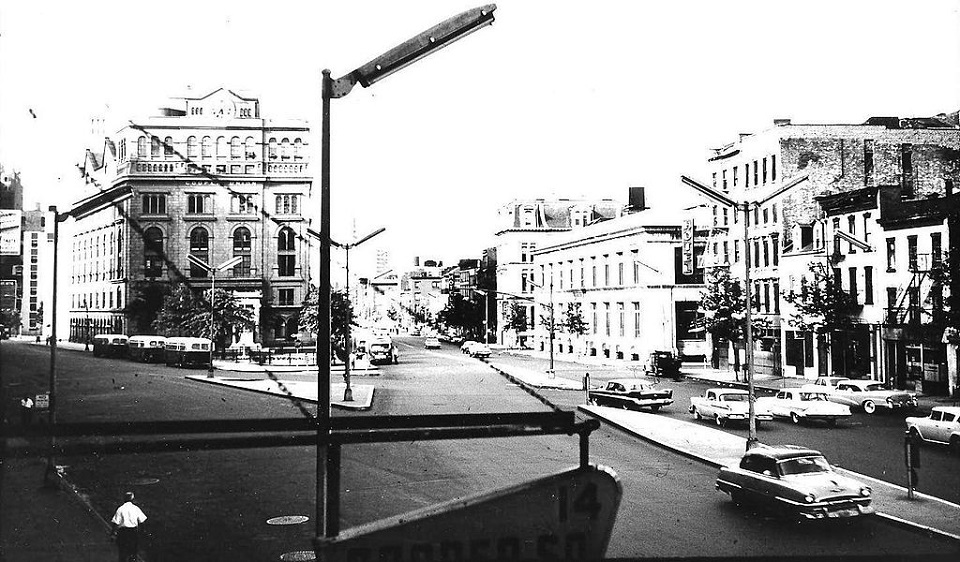
If you’ve been around housing movements in New York City or the U.S., or maybe anywhere, you have probably heard about a place called Cooper Square, where the people did the impossible: beat back the real estate speculators and aligned power brokers to take control of a piece of their neighborhood, creating permanently affordable social housing while supporting a flourishing arts infrastructure and a slew of small businesses.
A good amount of people know that this happened; far fewer know how it happened. The new documentary film Rabble Rousers: Frances Goldin and the Fight for Cooper Square, which opens March 24th at the Firehouse Theater in Manhattan’s Chinatown, aims to change that.
Rabble Rousers tells the story of Cooper Square, a 12-block section of Manhattan’s Lower East Side, and its legendary lead organizer, Frances Goldin. The film takes viewers from Goldin’s youth in the 1920s to the day in 2012 when the Cooper Square Community Land Trust (CLT) and Mutual Housing Association formally took over the area’s land and buildings. It’s a long and complicated story to tell, and producing this film has been a labor of love from directors Kelly Anderson, Ryan Joseph, and Kathryn Barnier for over a decade.
Full disclosure: I’m biased. The directors are friends of mine. Some of the people interviewed have been my teachers and mentors, and many of the activists who speak in the film are colleagues whom I’ve collaborated with on campaigns and educational projects. The first time I organized a protest I asked Frances Goldin to speak. So maybe it’s no surprise that I think this is a fantastic film that everyone with an interest in housing movements and grassroots planning should see. But my bias also means I’d be pretty pissed off if I felt the directors missed the mark—if the story they were telling didn’t line up with the history, or betrayed the true character of the people it presents. From my perspective, they nailed it.
Rabble Rousers does several things that will be notable to an audience of progressive planners. First, it tells the history of the struggle for Cooper Square, from being slated for Urban Renewal demolition in the late 1950s to the formation of the Community Land Trust, with plenty of attention paid to all the unpredictable forks in the road. The filmmakers tell the story through interviews with CLT organizers and members (including Goldin, Tito Delgado, Val Orseli, Gisela Jasmine Gomez, Amir Bey, and Maria Torres-Bird) and connected scholar-activists (Frances Fox Piven, Tom Angotti, Ron Shiffman), archival footage, documents brought to life with animation, a helpful timeline, and plenty of character development. We see the community come together not just to oppose their own displacement, but to work with Walter Thabit—one of the co-founders of the Planner’s Network’s precursor organization, Planners for Equal Opportunity—to create their own alternate plan, premised on the idea that the people themselves could determine which structures should be saved, built or demolished.

The plan called for the city to use a “checkerboarding” strategy to house the neighborhood’s poor and working-class residents without displacement. They wanted the city to build public housing on a large vacant lot, move tenants from nearby decrepit housing into that development, tear down the bad old housing, rebuild it, move tenants from other nearby decrepit housing into that development, and repeat until everyone in the neighborhood had decent housing. They fought Robert Moses, Richard Nixon, and every mayor from Robert F. Wagner to Ed Koch until they reformulated their plan and won control of their buildings through a Community Land Trust.
In the course of this telling, the film also demonstrates and explains key concepts that can often be confusing or overly abstract. First, this film is as good as anything at showing what Community Land Trusts (CLTs) and Mutual Housing Associations are, how they work, why they keep an area affordable, and what it takes to win them. Rabble Rousers also helps demonstrate the relationship between complex socio-spatial processes like disinvestment, “planned shrinkage,” gentrification, and community control through a concrete, historically, and geographically specific example.
The documentary also examines an important piece of political history that is not often a part of our discourse around community planning: the early relationship between the fight for public housing and the fight for CLTs. Cooper Square Community Land Trust is known best as a functioning example of this model of community land and housing stewardship. The CLT movement is sometimes thought of as distinct from the movement for public housing. In fact, it can be seen as a turn away from large-scale state ownership of land and housing and toward a smaller-scale vision of community control. But Rabble Rousers shows us that for the people who built the CLT, public housing was always Plan A. It was only after the Nixon Administration put a moratorium on federal public housing construction and the city government entered into a fiscal crisis that the activists devised the CLT alternative. In other words, the activists didn’t give up on public housing, the state did. This subtle but crucial corrective is reason alone to watch this film.
The filmmakers don’t sugarcoat the way the CLT got the land and the funds to renovate their decaying buildings. According to Cooper Square veteran Val Orseli, realizing that they had built up “the power to block” but didn’t “have the money to build,” they allowed the city to sell two large vacant lots at the southern edge of the neighborhood—which were the cornerstones of the public housing “checkerboarding” strategy—to private developers to build luxury housing. In exchange, they got 25 percent affordability in those two new buildings, and more importantly, secured tens of millions of dollars from the city to bring their buildings up to code. Once the buildings were renovated, they were transferred over to the community in the form of a Community Land Trust and a Mutual Housing Association, with apartments selling for $250 each and never appreciating in exchange value. There is still more to this story—we aren’t told where people moved to while the city was fixing their apartments, and I’m pretty sure federal vouchers are also a part of Cooper Square’s financing strategy—but the filmmakers don’t shy away from the fact that while they won something incredible, there were real costs and trade-offs involved.
Finally, Rabble Rousers closes by pointing its audience to the future. As the credits roll, we see a new generation of activists organizing to establish East Harlem/El Barrio CLT, about five miles north of Cooper Square. We see tenant activist Raquel Namuche Pacheco organizing a building (sounding a lot like a young Frances Goldin) and Picture the Homeless member and activist Marcus Moore talking about Cooper Square’s inspiration (sounding a lot like a young Tito Delgado). By closing with its gaze on a new CLT struggle, the film reminds us why Cooper Square matters, not just for itself, but as an inspiration for popular movements near and far.
But the film also closes on a sober note: Cooper Square may be forever affordable, but what about all that surrounds it? Frances Fox Piven notes that “The harms done by Robert Moses shrink if you compare them to the harms done by Mayor Michael Bloomberg,” and urges us to view the Cooper Square story as two truths at once: a remarkable achievement, and also a drop in the bucket. This may not be the triumphant conclusion many viewers expect, given that Cooper Square is often treated—accurately!—as a historic victory over enormous odds.
If Rabble Rousers is the story of a victory in community planning and the CLT movement, it’s also a demonstration of those movements’ limits. Community-based planning is just that: community-based. Without control over the state and capital, it can only ever be local and partial. This is not anything the protagonists of this story don’t know already: Frances Goldin got into this movement via Communism, and while she left the Party (or the Party left her) she remained a radical and an internationalist to the end. Shortly before she died in 2020, when much of her memory had left her, I saw a video of her singing every word of “Der Internatsyonal” (“The Internationale” in Yiddish). She may have dedicated much of her time to a hyper-local struggle, but she never took her gaze off of the wider world.
For those working in Goldin’s political lineage, the question this forces us to grapple with is: How do we engage in local struggle without losing sight of what lies beyond? What’s our theory of how local struggles relate to the rest of the world, and to the global capitalist system that structures our local politics? One can reasonably argue any of the following: that the demand to “scale up” local struggles is in fact a masculinist imposition on anything that works on a smaller scale; that a network of local projects can join together and take on the world; that we can do it all at once, and organize both local projects and global uprisings; or that the global is simply beyond the reach of our movements right now, and so we do what we can where we are.
Any of these are plausible responses, but we need some kind of theory to explain the duality Piven poses at the end of this film: the presence of Cooper Square and the disappearance of much that once surrounded it. Watching Rabble Rousers should get us all thinking about what that answer might be.
In the closing moments of the film, Goldin says, “I think that fighting back is a very life-giving force.” She explains that organizing and protesting forced her to have hope and to keep going for over 90 years.
I’m 40. Some days my stockpile of hope is in short supply. I’m sure sometimes Frances Goldin felt the same way. But she didn’t quit, right up to her dying days. This film is a reminder that it may take 50 years, but victories do come. And the day after they come, there’s still a world to win.
This review originally appeared in Progressive City. It has been edited slightly to conform to People’s World style and format.
We hope you appreciated this article. Before you go, please support great working-class and pro-people journalism by donating to People’s World.
We are not neutral. Our mission is to be a voice for truth, democracy, the environment, and socialism. We believe in people before profits. So, we take sides. Yours!
We are part of the pro-democracy media contesting the vast right-wing media propaganda ecosystem brainwashing tens of millions and putting democracy at risk.
Our journalism is free of corporate influence and paywalls because we are totally reader supported. At People’s World, we believe news and information should be free and accessible to all.
But we need your help. It takes money—a lot of it—to produce and cover unique stories you see in our pages. Only you, our readers and supporters, make this possible. If you enjoy reading People’s World and the stories we bring you, support our work by donating or becoming a monthly sustainer today.

MOST POPULAR TODAY


Zionist organizations leading campaign to stop ceasefire resolutions in D.C. area

Communist Karol Cariola elected president of Chile’s legislature

Afghanistan’s socialist years: The promising future killed off by U.S. imperialism

High Court essentially bans demonstrations, freedom of assembly in Deep South






Comments